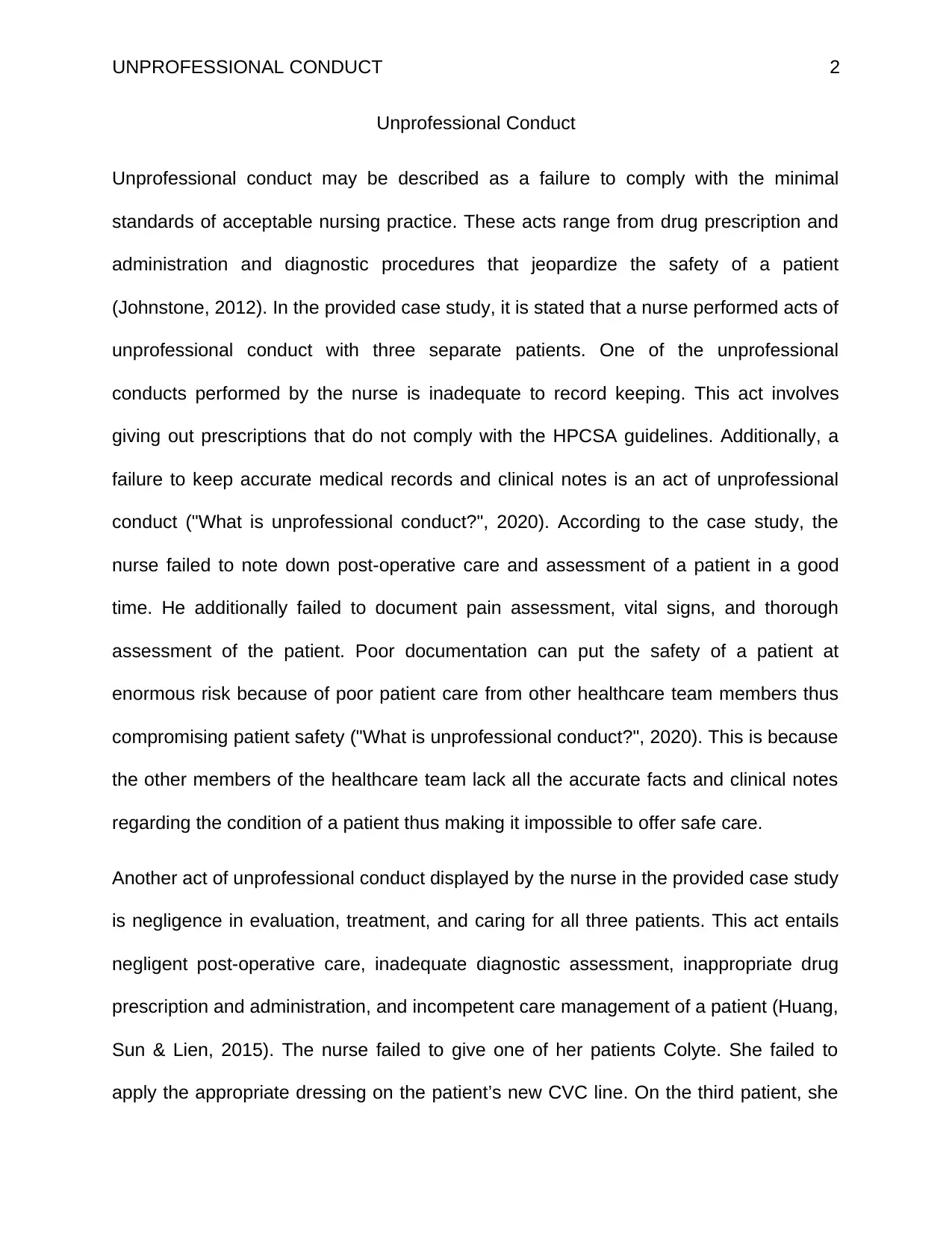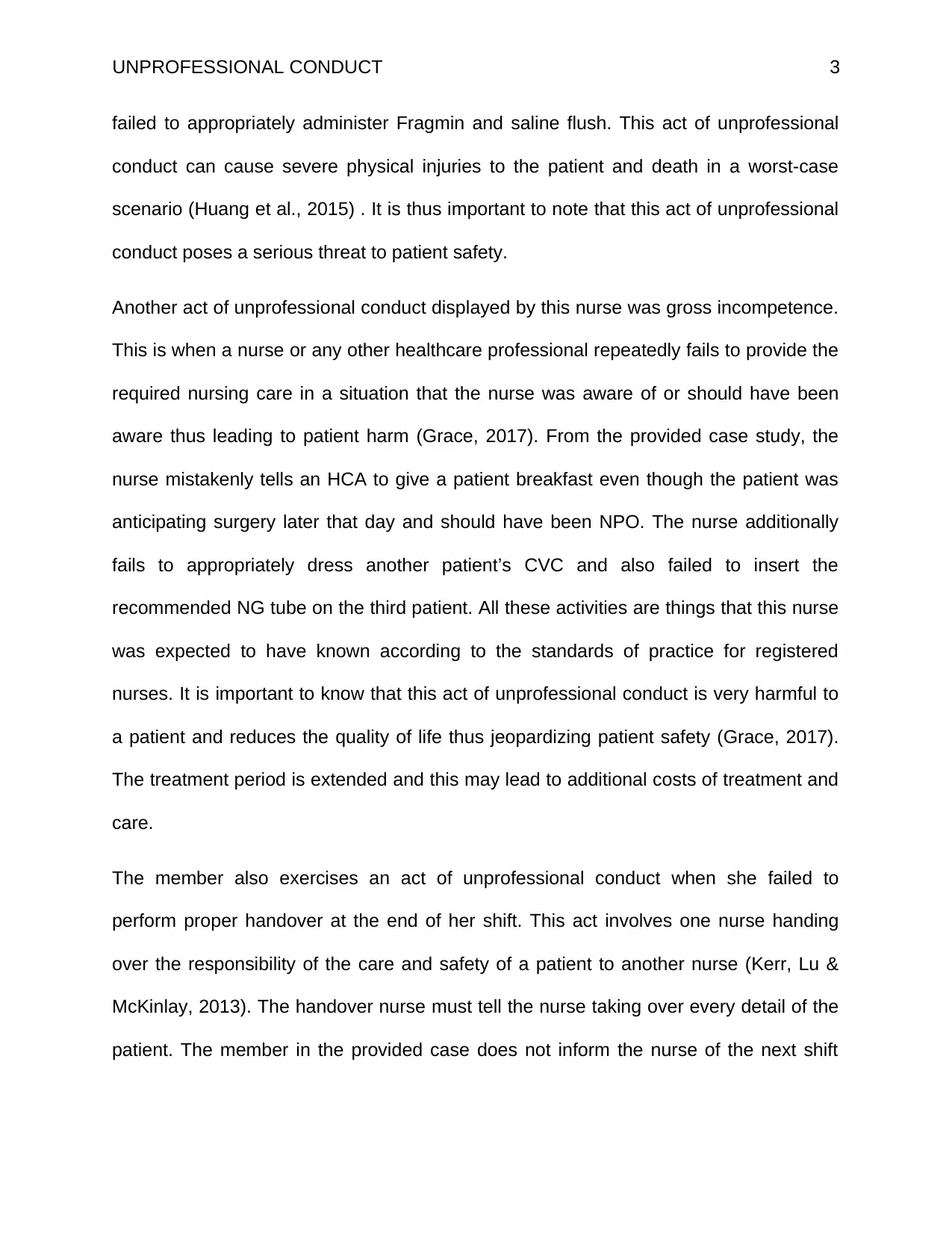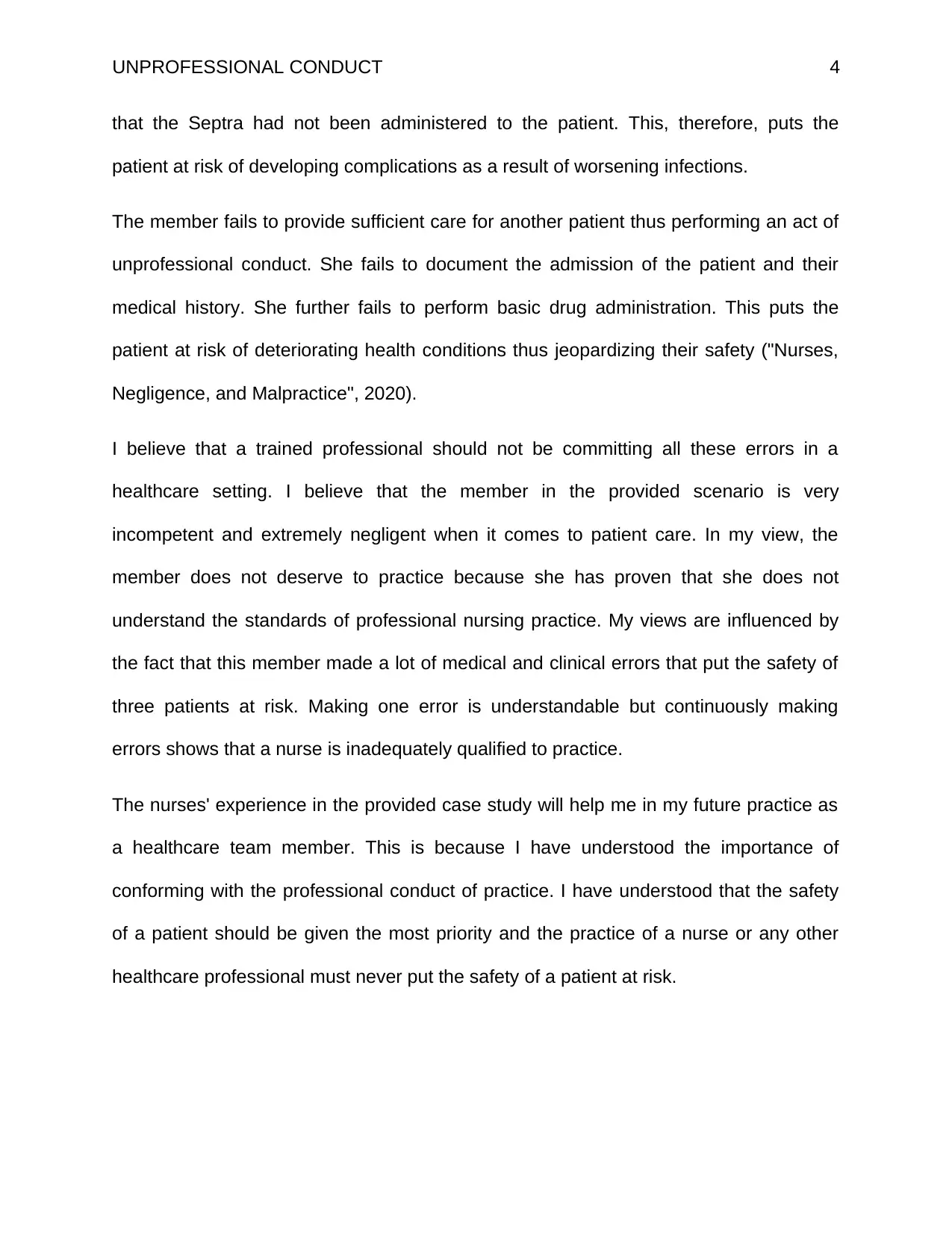Case Study: Analysis of Unprofessional Conduct in Nursing Practice
VerifiedAdded on 2022/08/12
|5
|1147
|23
Case Study
AI Summary
This assignment analyzes a case study involving a nurse's unprofessional conduct across three patients. The analysis identifies key issues, including inadequate record-keeping, negligence in evaluation and treatment, gross incompetence, and failure to perform proper handover. The nurse's actions resulted in multiple errors, such as improper drug administration, failure to provide necessary care, and incomplete documentation, which compromised patient safety. The author emphasizes the importance of adhering to professional standards and prioritizes patient well-being, highlighting the consequences of medical and clinical errors. The assignment concludes with the author's viewpoint on the nurse's lack of competence and the impact of the case study on their future practice as a healthcare professional.

Running head: UNPROFESSIONAL CONDUCT 1
Unprofessional Conduct
Name
Institution
Unprofessional Conduct
Name
Institution
Paraphrase This Document
Need a fresh take? Get an instant paraphrase of this document with our AI Paraphraser

UNPROFESSIONAL CONDUCT 2
Unprofessional Conduct
Unprofessional conduct may be described as a failure to comply with the minimal
standards of acceptable nursing practice. These acts range from drug prescription and
administration and diagnostic procedures that jeopardize the safety of a patient
(Johnstone, 2012). In the provided case study, it is stated that a nurse performed acts of
unprofessional conduct with three separate patients. One of the unprofessional
conducts performed by the nurse is inadequate to record keeping. This act involves
giving out prescriptions that do not comply with the HPCSA guidelines. Additionally, a
failure to keep accurate medical records and clinical notes is an act of unprofessional
conduct ("What is unprofessional conduct?", 2020). According to the case study, the
nurse failed to note down post-operative care and assessment of a patient in a good
time. He additionally failed to document pain assessment, vital signs, and thorough
assessment of the patient. Poor documentation can put the safety of a patient at
enormous risk because of poor patient care from other healthcare team members thus
compromising patient safety ("What is unprofessional conduct?", 2020). This is because
the other members of the healthcare team lack all the accurate facts and clinical notes
regarding the condition of a patient thus making it impossible to offer safe care.
Another act of unprofessional conduct displayed by the nurse in the provided case study
is negligence in evaluation, treatment, and caring for all three patients. This act entails
negligent post-operative care, inadequate diagnostic assessment, inappropriate drug
prescription and administration, and incompetent care management of a patient (Huang,
Sun & Lien, 2015). The nurse failed to give one of her patients Colyte. She failed to
apply the appropriate dressing on the patient’s new CVC line. On the third patient, she
Unprofessional Conduct
Unprofessional conduct may be described as a failure to comply with the minimal
standards of acceptable nursing practice. These acts range from drug prescription and
administration and diagnostic procedures that jeopardize the safety of a patient
(Johnstone, 2012). In the provided case study, it is stated that a nurse performed acts of
unprofessional conduct with three separate patients. One of the unprofessional
conducts performed by the nurse is inadequate to record keeping. This act involves
giving out prescriptions that do not comply with the HPCSA guidelines. Additionally, a
failure to keep accurate medical records and clinical notes is an act of unprofessional
conduct ("What is unprofessional conduct?", 2020). According to the case study, the
nurse failed to note down post-operative care and assessment of a patient in a good
time. He additionally failed to document pain assessment, vital signs, and thorough
assessment of the patient. Poor documentation can put the safety of a patient at
enormous risk because of poor patient care from other healthcare team members thus
compromising patient safety ("What is unprofessional conduct?", 2020). This is because
the other members of the healthcare team lack all the accurate facts and clinical notes
regarding the condition of a patient thus making it impossible to offer safe care.
Another act of unprofessional conduct displayed by the nurse in the provided case study
is negligence in evaluation, treatment, and caring for all three patients. This act entails
negligent post-operative care, inadequate diagnostic assessment, inappropriate drug
prescription and administration, and incompetent care management of a patient (Huang,
Sun & Lien, 2015). The nurse failed to give one of her patients Colyte. She failed to
apply the appropriate dressing on the patient’s new CVC line. On the third patient, she

UNPROFESSIONAL CONDUCT 3
failed to appropriately administer Fragmin and saline flush. This act of unprofessional
conduct can cause severe physical injuries to the patient and death in a worst-case
scenario (Huang et al., 2015) . It is thus important to note that this act of unprofessional
conduct poses a serious threat to patient safety.
Another act of unprofessional conduct displayed by this nurse was gross incompetence.
This is when a nurse or any other healthcare professional repeatedly fails to provide the
required nursing care in a situation that the nurse was aware of or should have been
aware thus leading to patient harm (Grace, 2017). From the provided case study, the
nurse mistakenly tells an HCA to give a patient breakfast even though the patient was
anticipating surgery later that day and should have been NPO. The nurse additionally
fails to appropriately dress another patient’s CVC and also failed to insert the
recommended NG tube on the third patient. All these activities are things that this nurse
was expected to have known according to the standards of practice for registered
nurses. It is important to know that this act of unprofessional conduct is very harmful to
a patient and reduces the quality of life thus jeopardizing patient safety (Grace, 2017).
The treatment period is extended and this may lead to additional costs of treatment and
care.
The member also exercises an act of unprofessional conduct when she failed to
perform proper handover at the end of her shift. This act involves one nurse handing
over the responsibility of the care and safety of a patient to another nurse (Kerr, Lu &
McKinlay, 2013). The handover nurse must tell the nurse taking over every detail of the
patient. The member in the provided case does not inform the nurse of the next shift
failed to appropriately administer Fragmin and saline flush. This act of unprofessional
conduct can cause severe physical injuries to the patient and death in a worst-case
scenario (Huang et al., 2015) . It is thus important to note that this act of unprofessional
conduct poses a serious threat to patient safety.
Another act of unprofessional conduct displayed by this nurse was gross incompetence.
This is when a nurse or any other healthcare professional repeatedly fails to provide the
required nursing care in a situation that the nurse was aware of or should have been
aware thus leading to patient harm (Grace, 2017). From the provided case study, the
nurse mistakenly tells an HCA to give a patient breakfast even though the patient was
anticipating surgery later that day and should have been NPO. The nurse additionally
fails to appropriately dress another patient’s CVC and also failed to insert the
recommended NG tube on the third patient. All these activities are things that this nurse
was expected to have known according to the standards of practice for registered
nurses. It is important to know that this act of unprofessional conduct is very harmful to
a patient and reduces the quality of life thus jeopardizing patient safety (Grace, 2017).
The treatment period is extended and this may lead to additional costs of treatment and
care.
The member also exercises an act of unprofessional conduct when she failed to
perform proper handover at the end of her shift. This act involves one nurse handing
over the responsibility of the care and safety of a patient to another nurse (Kerr, Lu &
McKinlay, 2013). The handover nurse must tell the nurse taking over every detail of the
patient. The member in the provided case does not inform the nurse of the next shift
⊘ This is a preview!⊘
Do you want full access?
Subscribe today to unlock all pages.

Trusted by 1+ million students worldwide

UNPROFESSIONAL CONDUCT 4
that the Septra had not been administered to the patient. This, therefore, puts the
patient at risk of developing complications as a result of worsening infections.
The member fails to provide sufficient care for another patient thus performing an act of
unprofessional conduct. She fails to document the admission of the patient and their
medical history. She further fails to perform basic drug administration. This puts the
patient at risk of deteriorating health conditions thus jeopardizing their safety ("Nurses,
Negligence, and Malpractice", 2020).
I believe that a trained professional should not be committing all these errors in a
healthcare setting. I believe that the member in the provided scenario is very
incompetent and extremely negligent when it comes to patient care. In my view, the
member does not deserve to practice because she has proven that she does not
understand the standards of professional nursing practice. My views are influenced by
the fact that this member made a lot of medical and clinical errors that put the safety of
three patients at risk. Making one error is understandable but continuously making
errors shows that a nurse is inadequately qualified to practice.
The nurses' experience in the provided case study will help me in my future practice as
a healthcare team member. This is because I have understood the importance of
conforming with the professional conduct of practice. I have understood that the safety
of a patient should be given the most priority and the practice of a nurse or any other
healthcare professional must never put the safety of a patient at risk.
that the Septra had not been administered to the patient. This, therefore, puts the
patient at risk of developing complications as a result of worsening infections.
The member fails to provide sufficient care for another patient thus performing an act of
unprofessional conduct. She fails to document the admission of the patient and their
medical history. She further fails to perform basic drug administration. This puts the
patient at risk of deteriorating health conditions thus jeopardizing their safety ("Nurses,
Negligence, and Malpractice", 2020).
I believe that a trained professional should not be committing all these errors in a
healthcare setting. I believe that the member in the provided scenario is very
incompetent and extremely negligent when it comes to patient care. In my view, the
member does not deserve to practice because she has proven that she does not
understand the standards of professional nursing practice. My views are influenced by
the fact that this member made a lot of medical and clinical errors that put the safety of
three patients at risk. Making one error is understandable but continuously making
errors shows that a nurse is inadequately qualified to practice.
The nurses' experience in the provided case study will help me in my future practice as
a healthcare team member. This is because I have understood the importance of
conforming with the professional conduct of practice. I have understood that the safety
of a patient should be given the most priority and the practice of a nurse or any other
healthcare professional must never put the safety of a patient at risk.
Paraphrase This Document
Need a fresh take? Get an instant paraphrase of this document with our AI Paraphraser

UNPROFESSIONAL CONDUCT 5
References
Johnstone, M. J. (2012). Unethical professional conduct. Australian Nursing Journal:
ANJ, The, 19(11), 34.
Huang, H. M., Sun, F. K., & Lien, Y. F. (2015). Nurse Practitioners, medical negligence
and crime: A case study. source: Clinical Nursing Studies, 3(4), 21-28.
Grace, P. J. (Ed.). (2017). Nursing ethics and professional responsibility in advanced
practice. Jones & Bartlett Learning.
Kerr, D., Lu, S., & McKinlay, L. (2013). Bedside handover enhances completion of
nursing care and documentation. Journal of nursing care quality, 28(3), 217-225.
What is unprofessional conduct?. (2020). Retrieved 1 March 2020, from
https://medicalboard.georgia.gov/what-unprofessional-conduct
Nurses, Negligence, and Malpractice. (2020). Retrieved 1 March 2020, from
https://www.nursingcenter.com/journalarticle?
Article_ID=423284&Journal_ID=54030&Issue_ID=423107
References
Johnstone, M. J. (2012). Unethical professional conduct. Australian Nursing Journal:
ANJ, The, 19(11), 34.
Huang, H. M., Sun, F. K., & Lien, Y. F. (2015). Nurse Practitioners, medical negligence
and crime: A case study. source: Clinical Nursing Studies, 3(4), 21-28.
Grace, P. J. (Ed.). (2017). Nursing ethics and professional responsibility in advanced
practice. Jones & Bartlett Learning.
Kerr, D., Lu, S., & McKinlay, L. (2013). Bedside handover enhances completion of
nursing care and documentation. Journal of nursing care quality, 28(3), 217-225.
What is unprofessional conduct?. (2020). Retrieved 1 March 2020, from
https://medicalboard.georgia.gov/what-unprofessional-conduct
Nurses, Negligence, and Malpractice. (2020). Retrieved 1 March 2020, from
https://www.nursingcenter.com/journalarticle?
Article_ID=423284&Journal_ID=54030&Issue_ID=423107
1 out of 5
Related Documents
Your All-in-One AI-Powered Toolkit for Academic Success.
+13062052269
info@desklib.com
Available 24*7 on WhatsApp / Email
![[object Object]](/_next/static/media/star-bottom.7253800d.svg)
Unlock your academic potential
Copyright © 2020–2025 A2Z Services. All Rights Reserved. Developed and managed by ZUCOL.





